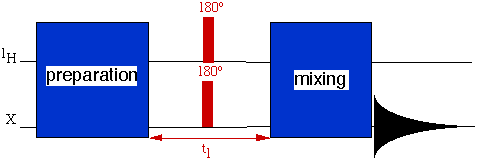
|
Heteronuclear spin-echo
t1 period
|
DESCRIPTION
180º pulses placed into heteronuclear pulse sequences can be used
to refocus a desired chemical-shift, homo- or heteronuclear J-coupling
information, depending of the position into the pulse sequence and on the
nuclei that they are applied.
If refocusing 180º pulses are applied on both 1H and
13C nuclei, both 1H and 13C chemical shifts
are refocused at the end of the echo period while 1H-1H
and 1H-13C coupling constants are not affected.


Some typicals examples are i) the variable evolution period
in the standard 2D SPIN-FLIP
experiment which can be used to measure heteronuclear coupling constants
and ii) the evolution periods in INEPT and
refocused INEPT pulse trains.
REQUIREMENTS
Easy implementation on AVANCE spectrometers.
EXPERIMENTAL DETAILS
There are 32 duration parameters, d0-d31, to be
specified in seconds. They are executed as delays without any further actions
by the pulse program commands d0. They can be incremented or decremented
using the pulse program commands id0-id31 or dd0-dd31, respectively.
The changes are given by the parameters IN0-IN31. The pulse program
commands rd0-rd31 reset a respective delay to its original value.
The delays may also be changed by means of arithmetic expressions during
pulse program execution.
SYNTAX
The most standard way to implement a variable heteronuclear
spin-echo t1 period should be:
...
d0
(p2 ph1) (p4
ph2):f2
d0
...
|
|
in which:
-
d0 is the incremented delay (in seconds).
-
p2 is the 180º X pulse (in microseconds) applied at a
power level pl1 from the f1 channel.
-
p4 is the 180º 1H pulse (in microseconds) applied
at a power level pl2 from the f2 channel.
-
All phases may be specified at the end of pulse program.
RELATED TOPICS
